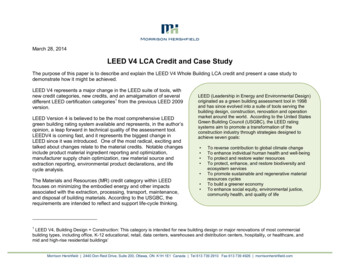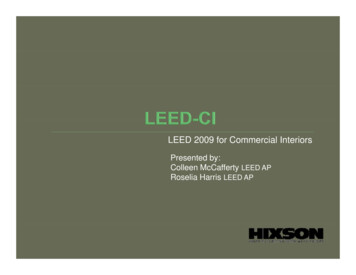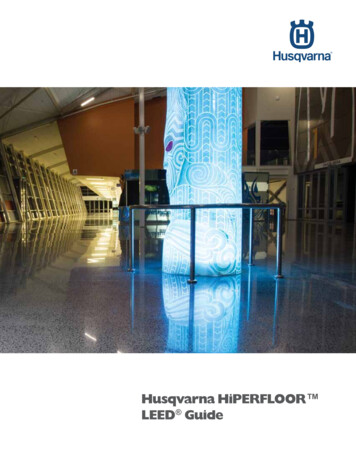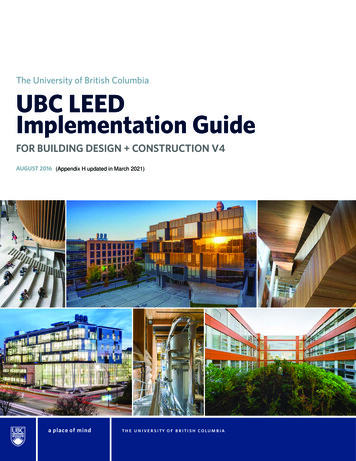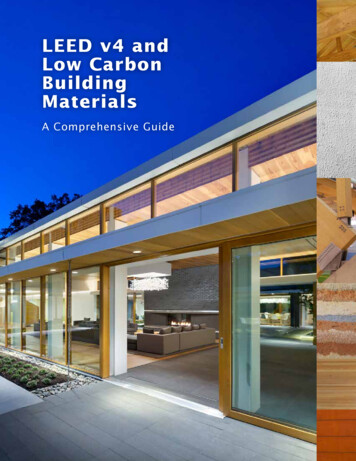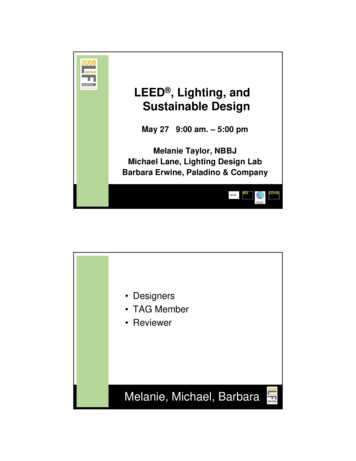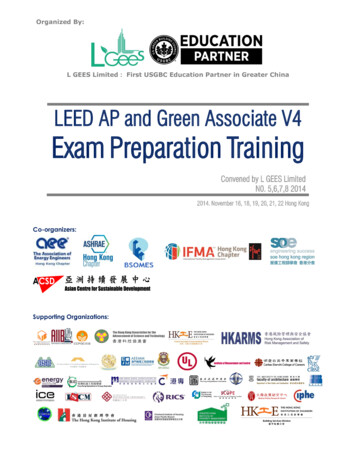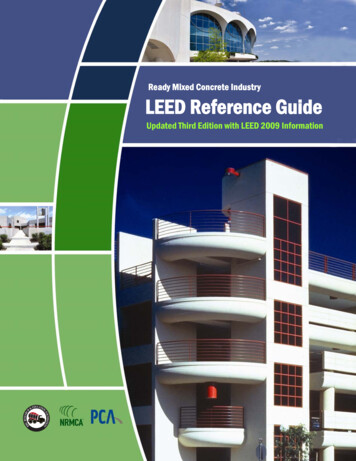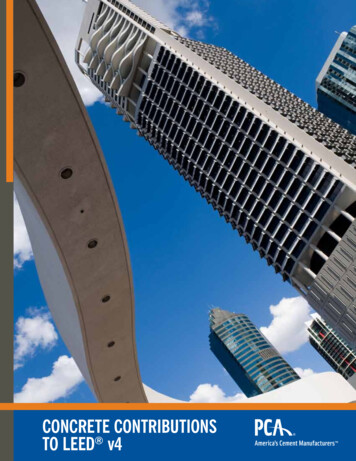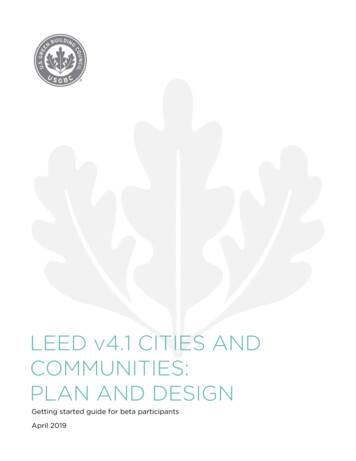
Transcription
LEED v4.1 CITIES ANDCOMMUNITIES:PLAN AND DESIGNGetting started guide for beta participantsApril 2019
ContentsWELCOME TO LEED V4.1 . 5PROGRAM OVERVIEW . 8WHAT YOU NEED TO KNOW . 12LEED FOR CITIES AND COMMUNITIES SCORECARD . 14INTEGRATIVE PROCESS (IP) . 16IP PREREQUISITE: INTEGRATIVE PLANNING AND DESIGN PROCESS . 16IP CREDIT: GREEN BUILDING POLICY AND INCENTIVES . 18NATURAL SYSTEMS AND ECOLOGY (NS) . 20NS PREREQUISITE: ECOSYSTEM ASSESSMENT . 20NS PREREQUISITE: CONSTRUCTION ACTIVITY POLLUTION PREVENTION . 22NS PREREQUISITE: GREEN SPACES . 23NS CREDIT: NATURAL RESOURCES CONSERVATION AND RESTORATION . 25NS CREDIT: LIGHT POLLUTION REDUCTION . 29NS CREDIT: RESILIENCE PLANNING . 31TRANSPORTATION AND LAND USE (TR) .34TR CREDIT: COMPACT, MIXED USE AND TRANSIT ORIENTED DEVELOPMENT .34TR CREDIT: WALKABILITY AND BIKEABILITY . 37TR CREDIT: ACCESS TO QUALITY TRANSIT . 40TR CREDIT: ALTERNATIVE FUEL VEHICLES .43TR CREDIT: SMART MOBILITY AND TRANSPORTATION POLICY .45TR CREDIT: HIGH-PRIORITY SITE . 47WATER EFFICIENCY (WE) . 50WE PREREQUISITE: INTEGRATED WATER MANAGEMENT . 50WE PREREQUISITE: WATER ACCESS AND QUALITY . 53WE CREDIT: STORMWATER MANAGEMENT. 562U.S. Green Building Council
WE CREDIT: WASTEWATER MANAGEMENT . 59WE CREDIT: SMART WATER SYSTEMS . 61ENERGY AND GREENHOUSE GAS EMISSIONS (EN) . 62EN PREREQUISITE: POWER ACCESS, RELIABILITY AND RESILIENCY . 62EN PREREQUISITE: ENERGY AND GREENHOUSE GAS EMISSIONS MANAGEMENT . 65EN CREDIT: ENERGY EFFICIENCY . 68EN CREDIT: RENEWABLE ENERGY . 70EN CREDIT: LOW CARBON ECONOMY . 73EN CREDIT: GRID HARMONIZATION. 74MATERIALS AND RESOURCES (MR) . 76MR PREREQUISITE: CONSTRUCTION AND DEMOLITION WASTE MANAGEMENT . 76MR PREREQUISITE: SOLID WASTE MANAGEMENT . 78MR CREDIT: ORGANIC WASTE TREATMENT . 82MR CREDIT: RECYCLING INFRASTRUCTURE .84MR CREDIT: RESPONSIBLE SOURCING FOR INFRASTRUCTURE . 87MR CREDIT: SMART WASTE MANAGEMENT SYSTEMS . 89QUALITY OF LIFE (QL) . 91QL PREREQUISITE: DEMOGRAPHIC ASSESSMENT . 91QL PREREQUISITE: SOCIAL INFRASTRUCTURE . 92QL PREREQUISITE: ECONOMIC GROWTH . 94QL CREDIT: AFFORDABLE HOUSING .96QL CREDIT: PUBLIC HEALTH . 97QL CREDIT: EMERGENCY MANAGEMENT AND RESPONSE .99INNOVATION (IN) . 101IN CREDIT: INNOVATION . 101REGIONAL PRIORITY (RP) . 1033U.S. Green Building Council
RP CREDIT: REGIONAL PRIORITY . 103APPENDICES . 1054U.S. Green Building Council
Welcome to LEED v4.1Welcome to the next evolution of LEED for Cities and Communities! Whether you are a seasoned LEEDpractitioner, or new to LEED, we encourage you to test out this bigger, stronger, bolder rating systemfor your city or community and to be a leader in shaping the future of sustainability performance.Six key goals have guided the technical development process for the LEED v4.1 Cities and Communitiesprogram: inspire leadershipfoster achievement of global goalsensure continuity of performance from design to development and operationleverage the large portfolio of complementing systems in GBCI portfolio, particularly STARexpand the market from buildings to cities and communitiesfocus on quality of life of residents and enhance living standardsThis version of LEED is the result of countless hours of effort from our volunteers and staff and we areconfident that the rating system meets those goals.LEED is a global rating system for the design, construction and operation of high-performance greenbuildings. For the last 18 years, various versions of LEED have pushed the global green building marketforward progressively, with more than 93,000 registered and certified projects and more than 19 billionsquare feet of space worldwide.Regions and markets move at different paces, and we want to be sure we can meet the needs ofeveryone in the green building and sustainability community. LEED v4.1 represents a series of upgradesthat will improve our standards, encourage leadership, and make our platform more user friendly, moreaccessible—and most importantly—more collaborative than ever before.LEED v4.1 will be our most inclusive and transparent platform to date. That is because our mostimportant requirement for adoption will come from our most valuable resource of all—YOU!Highlights of LEED v4.1 Cities and CommunitiesIntegrativeProcess (IP) 5The rating system has an overarching prerequisite and a credit. The prerequisiteintends to drive an inclusive process in city or community planning, while the creditensures that a majority of buildings in the city or community are green andsustainable by design.The prerequisite on integrative planning and design facilitates teamwork for earlyanalysis of city systems to derive cost effective, high performance outcomes.The credit is a facilitator for green buildings in the city or community. Buildings areprimary constituents of any city or community that can contribute to higher energyand water consumption, higher waste generation and could lead to environmentaldegradation, if not designed and operated sustainably. The design and operation ofgreen buildings support and contribute to better environmental, social andeconomic goals of a city and community. The rating system thus encourages citiesto introduce policies, incentives and programs to encourage design constructionand operation of green buildings certified to LEED or any other equivalent greenbuilding rating system, as an overarching credit.U.S. Green Building Council
Ecology andNatural Systems(EN) Transportationand Land Use(TR) 1Cities depend on nature and ecosystem services to not only sustain life but alsoenhance the quality of life. Ecosystems protect and even regenerate naturalsystems, thereby increasing the ecosystem services they provide and creatingecologically resilient communities. These are better able to withstand and recoverfrom episodic floods, droughts, wildfires, and other catastrophic events.This category consists of prerequisites on Ecosystem Assessment, ConstructionActivity Pollution Prevention and Green Spaces, which outline the stepsto analyze and respond to the local ecosystem; prevent or reduce pollution resultingfrom construction; cater to minimum green spaces essential for community healthand well-being; and enhance environmental quality.Credits on Natural Resource Conservation and Restoration and Light PollutionReduction focus on maintaining the integrity of the natural ecosystems and thenecessary steps to conserve and restore ecosystems and to reduce the adverseimpacts of lighting.Resilience Planning requires the city to generate awareness about climate risks andbuild strategies to effectively tolerate disturbances when faced with shocks andstresses. It also encourages cities and communities to carry out comprehensiveclimate risk assessments and prepare resilience plans.The transport sector is responsible for a quarter of energy-related greenhouse gas(GHG) emissions worldwide. 1 Land use is the key driver of mobility in a city andrapid urbanization has disrupted land use patterns, resulting in urban sprawl andincreased dependency on personal, motorized vehicles. This credit categoryencourages cities to adopt an integrated approach towards urban planning throughmixed use development, efficient transportation, better connectivity andengagement with stakeholders.This category does not have any prerequisites. The credit on Compact, Mixed Useand Transit Oriented Development addresses land use and encourages compactdevelopment and access to diverse uses. This in turn discourages urban sprawl andencourages people to walk or bike thereby improving public health. The Walkabilityand Bikeability credit further lays out principles for designing safe walkable andbikeable cities and communities.Access to Quality Transit encourages use of diverse transportation modes toreduce the reliance on personal vehicles within the city or community. It alsoaddresses intermodal connectivity for easy access and transition from one mode oftransport to another.The credit on Alternative Fuel Vehicles encourages a shift to alternative fuelvehicles by providing infrastructure such as charging stations for electric vehiclesand through policies and incentives.Smart Mobility and Transportation Policy intends to promote efficiency inoperation of transport systems, user facilitation, policies and behavior change toreduce environmental impacts.The High Priority Site credit intends to preserve and revive the urban fabric of acity by promoting engagement, community development and social and ansport-sector-in-fighting-climate-change. Accessed on April 1, 2019.6U.S. Green Building Council
wellbeing. It also encourages preservation of historic structures and sites andfocuses on growth and redevelopment for infill and other priority locations.Water (WE) Energy andGreenhouse GasEmissions (EN) 27Water is the lifeline of any city. However, equity and access have been a majorchallenge in many cities. Water demand has been constantly increasing in urban andperi-urban areas and is stressing freshwater reserves, creating a perennial shortageof water in these cities. This credit category addresses water at multiple levels –meeting demand, maintaining water quality, reducing water losses, capturingstormwater, and managing urban floods.There are two prerequisites in this category. The prerequisite for Integrated WaterManagement requires reduced freshwater consumption and encourages the shift toa net zero water city.Water Access and Quality requires the implementation of policies andinfrastructure for the equitable supply of quality water to all members of society,along with the treatment of wastewater and stormwater before it is released intothe environment.The credit on Stormwater Management focuses on strategies to capture themaximum possible quantity of rainwater to reduce runoff volume, prevent erosion,and flooding, as well as recharge groundwater.The credit on Waste Water Management is designed reduce pollution fromwastewater, encourage water reuse and reduce stress on freshwater sources.Smart Water Systems encourages cities to improve operational efficiency,reduction in water losses, and monitoring of water flow within the city through theuse of smart technologies such as smart meters.Cities consume over two-thirds of the world’s energy and account for more than70% of global CO2 emissions. 2 City energy systems can play a huge role incombating climate change. In addition, access to energy is critical in determiningthe quality of life of residents. This credit category encourages cities to provideequitable access to reliable power while simultaneously reducing the adverseimpacts of energy use on environment.There are two prerequisites in this category. The second prerequisite is the onlyprerequisite in the rating system that carries a score. The prerequisite on PowerAccess, Reliability and Resiliency addresses equitable access to a reliable powersupply, along with system resiliency to withstand shocks and stresses.The second prerequisite that also has incremental scoring necessitates that the cityor community estimate and limit greenhouse gas (GHG) emissions from proposeddevelopment. The prerequisite on Energy and Emissions Management measuresthe GHG emissions per capita.The credit on Energy Efficiency focuses on actions for efficient water andwastewater services to the city, public lighting and district energy systems withinthe city.The Renewable Energy credit focuses on reducing the environmental impactsof conventional energy generation through installation of small scale and largescale renewables, as well as renewable energy certificates and carbon offsets inenergy procurement.https://www.c40.org/why citiesU.S. Green Building Council
Materials andResources (MR) Quality of Life(QL) As GHG emissions are driven by a city’s economic activity, the credit on LowCarbon Economy encourages the city to measure and lower the carbon intensity ofits economy.The credit for Grid Harmonization intends to improve operational efficiency of theenergy system and encourage consumer participation in energy useoptimization through the use of advanced technologies and the Internet of Things(IoT). This section leverages the Performance Excellence in Electricity Renewal(PEER) rating system that evaluates power generation, transmission and distributionsystems.Cities are large aggregators of materials and nutrients, accounting for the highestnatural resource consumption affecting the environment and human health. Theintent behind this category is to eliminate waste from mainstream consumption andinstead utilize waste as a resource. The development of cities provides opportunitiesto drive a global transition from a linear to a circular economy. With their highconcentration of resources, capital, data and skills over a small geographic territory,cities could greatly benefit from the outcomes of such a transition.There are two prerequisites that prepare a new city and community to strivetowards net zero waste and a circular economy through recycling, reuse andreduction of waste generation. The prerequisite for Construction and DemolitionWaste Management requires cities to reduce the disposal of C&D waste in landfillsand incineration facilities through recovery, reuse, and recycling.The Solid waste Management prerequisite requires cities to put up adequate wastemanagement infrastructure by properly estimating waste generation and diversion.Maximum diversion from landfills is the prime intent.The credits for Organic Waste Management and Recycling Infrastructure preparethe city or community to manage and treat organic and inorganic waste, so thatthere is a minimal load on landfills.Responsible Sourcing for Infrastructure encourages use of products and materialsthat have environmentally, economically, and socially preferable life cycle impacts.As in other credit categories, the Smart Waste Management credit promotesstrategies to improve operational efficiency of the waste management system.Quality of Life is the general well-being of individuals and populations in the city orcommunity. New cities are being developed as economic engines for theirrespective countries, thereby creating new jobs in the region. While the livabilityaspects of a city are mainly driven by the operations and management, thiscategory addresses design and planning interventions to promote prosperity,health, and safety for all.This credit category supports better quality of life for future residents. There arethree prerequisites: Demographic Assessment, SocialInfrastructure, and Economic Growth. These prerequisites require the city orcommunity to assess its population, provision for adequate social infrastructure, andprepare economic growth pathways.The Affordable Housing credit recognizes the importance of providing affordablehousing for all.The credit for Public Health assists cities and communities in planning for healthpromoting services and opportunities for all citizens, while the EmergencyManagement and Response credit requires sufficient capacity to respond toemergency incidents and reduce their impacts on human health.Program Overview8U.S. Green Building Council
LEED for Cities and Communities is the leading global rating system and certification program forevaluating the sustainability and quality of life in a city or community. Our program serves as a catalystand transformative tool toward more sustainable, equitable and resilient communities around the world.The rating system encompasses economic, environmental and social performance measures and providesa clear data-driven approach to benchmark and communicate progress.Like the suite of LEED rating systems for buildings, LEED for Cities and Communities is designed to beapplicable at all phases of a city’s or community’s lifecycle. New or developing cities, existing cities,neighborhoods or districts in redevelopment - all are examples of applicable projects. The flexible menuof standardized metrics and strategies in the rating system can be applied at various levels and stagesof development and allow data to be rolled from the project level all the way up to a city or a largerregional level. Sustainability strategies can be incorporated more effectively and efficiently at an earlystage of development. Cities can register as early as the conceptual phase and earn precertification.Cities with a Master Plan that is finalized can achieve full Plan and Design certification. Cities at thedevelopment phase can also apply the Plan and Design rating system. While the evaluation is based onthe Master Plan, these cities are encouraged to undertake additional strategies to ensure that they canmeet the prerequisite requirements. For example, if the city is under development and the master plandoes not meet the prerequisite requirements for green spaces, the city can incorporate innovativestrategies such as vertical gardens or urban rooftop gardens to meet the requirements.New cities and communities are mostly developed in phases. Projects with phases at various stages ofplanning and construction must follow the guidance provided below: Precertification: A project must use Plan and Design precertification for the full project.Precertification is mandatory for these projects.Certification:a. Plan and Design:: A project must use the Plan and Design rating system for the phasethat is at planning stage or is constructed less than 75% of its total building floor area.b. Existing: If the phase is constructed over 75%, it must use the Existing rating system andmust certify after being operational for a minimum period of one year.LEED for Cities and Communities is performance-driven and includes a verified certification program. Theresulting transparency and accountability of shared metrics and verified performance ensures a newgeneration of healthy, inclusive and prosperous places that offer people and businesses an environmentin which to thrive.This program aligns with our vision that buildings and communities will regenerate and sustain thehealth and vitality of all life within a generation. If you are designing a new city or community or if youare a city or community manager, we encourage you to test out this system. The rating system isintended to help cities and communities manage resources sustainably and provide a better quality oflife for residents and visitors. Lastly, the rating system supports the United Nations SustainableDevelopment Goals for environmentally-sensitive, socially-responsible and economically-viablecommunities.WHAT IS A CITY OR A COMMUNITY AS DEFINED BY LEED v4.1?The terms ‘Cities’ and ‘Communities’ are defined for purposes of the rating system as follows:Cities: Cities are political jurisdictions or places defined by their municipal public-sector governance(e.g., mayors or town managers) except in those regions (especially Asia) where the term ‘city’ isculturally understood as encompassing some places with private sector governance.Communities: Communities are defined as every urbanized location that is not a ‘city’ including sub-citylocations such as districts and meta-city regions such as counties. In addition, privately developed orowned urban areas (for example, Songdo District or Rockefeller Center) generally fit within thedefinition of ‘Community’ except where they are self-identified (per definition of ‘city’ above) as cities.WHO CAN PARTICIPATE?9U.S. Green Building Council
LEED for Cities and Communities is flexible so that local governments (counties and municipalities), aswell as the private sector, can use the rating system to achieve their goals. The primary applicant for LEEDfor Cities certification is the governing body of a city or municipality. LEED for Communities certificationapplies to non-city areas, such as counties, regions, districts, economic zones, neighborhoods, campusesand military installations.Examples of LEED for Cities and Communities: Plan and Design applicants include: A city manager representing a rapidly growing city A private sector planner developing a new city or community A local developer working on an eco-district or collection of buildings on an urban site/blockwithin a mature city A housing authority or local group developing a neighborhood Townships or large area development projects Neighborhood developments Large educational, institutional or industrial campuses and communitiesTECHNICAL DEVELOPMENT GOALSIn past three years of working with 140 cities globally to develop and refine LEED for Cities (throughthe LEED for Cities pilot program that precedes this beta and STAR Communities), USGBC and GBCIhave gained immense experience on the system. This has helped us to move to the next level oftechnical development. We have now expanded the program to cover new and greenfield cities andcommunities in addition to existing cities. Now, with the Plan and Design version of thesystem, greenfield cities and communities can incorporate actions, strategies, policies and programs toperform sustainably.The beta LEED for Cities and Communities rating system embeds the following inherent guidingprinciples in its development trajectory:LEED Impact categories, UN Sustainable Development Goals and Triple Bottom Line: The LEED for Cities and Communities rating system aligns with the seven Impact Categories ofLEED. The rating system addresses all of the Sustainable Development Goals set by United Nations in2015 to help cities achieve global goals. It upholds the triple bottom line and addresses social, environmental and financial aspects of acity.Future-Ready Cities: Requirements in the rating system encourage cities to adopt concepts of being carbon neutral,water positive, zero waste, human centric and equitable, transit oriented, connected throughsmart technologies, and integrated with a circular economy, to name a few. Social equity is a critical issue in contemporary cities. Cities and communities are encouraged tocater to social infrastructure at the design stage to support better quality of life andcommunity well-being.Integrated USGBC and GBCI Programs – LEED, STAR, SITES, PEER, LEED for Transit, TRUE: LEED for Cities and Communities is aligned with the STAR Community Rating System, LEED forNeighborhood Development, and other GBCI rating systems such as PEER, TRUE and SITES.o Integration of a prerequisite or credit from a rating system entails that the intent of thecredit is being met. This can be by (i) referencing the original credit as-is (ii) adapting thelanguage to fit the city or community scale, (iii) adapting the requirements to fit withinthe LEED framework, or (iv) using the same thresholds as the original credit.Reviewable Requirements: Selection of prerequisites and credits is based on their measurability and reviewability.o For example, Green Spaces has been included as a prerequisite in the Ecology andNatural Systems credit category, as vegetated area can be measured and reported atcity level and thus can be reviewed.10U.S. Green Building Council
Building on the Foundations of Global Best Practices: The rating system draws upon and references global best management practices whereverapplicable.o For instance, the Recycling Infrastructure credit has been developed based on thereview and analysis of programs, policies and regulations forextended producer responsibility, remanufacturing, sustainable consumption andproduction, and material recovery.Applicability at Global Level: To ensure global applicability of LEED for Cities and Communities, due consideration has beengiven to credit and prerequisite applicability in various geographies.o National or regional equivalencies, compliance paths, regional priority designations, andguidance will be developed subsequently.Encouraging Cities to Adopt Green Buildings: The LEED for Cities and Communities program aims to support USGBCs market transformationgoal at two levels. First, it encourages green practices at city scale; and second, at the buildinglevel, it encourages the city to adopt policies and regulations to support sustainability.11U.S. Green Building Council
What You Need to KnowAs a first step in launching LEED v4.1, USGBC released beta versions of each LEED rating system,allowing the market to work with the draft rating systems and provide feedback based on real-worldapplication.USGBC will present LEED v4.1 for public comment, followed by a member ballot. This beta ratingsystem is not final; feedback from the beta will inform the public comment draft(s). We will update thisdocument as needed and as more program features become available.This document is a comprehensive guide to the LEED Cities and Communities: Plan and Design v4.1 betaprogram. The v4.1 Beta Guide contains guidance sections for basic usability and there shall be detailedreference guide available in due course of time. The rating systems such as PEER V2, Star Communities,Sites, LEED ND are referenced in several credits. Projects are encouraged to access these systems andrespective reference guides to get further details and guidance.LEED CITIES AND COMMUNITIES V4.1 CERTIFICATION Registrationo Your first step is to confirm eligibility and select the appropriate rating system.o Next, register your project under the selected LEED Cities and Communities v4.1 betarating system in LEED Online at lo.usgbc.org.o For registration fees, view our detaile
LEED is a global rating system for the design, construction and operation of high-performance green buildings. For the last 18 years, various versions of LEED have pushed the global green building market forward progressively, with more than 93,000 registered and certified projects

